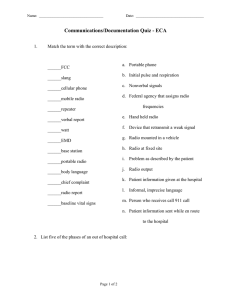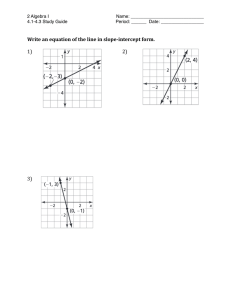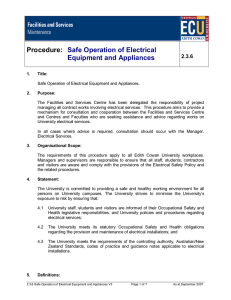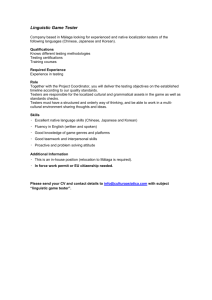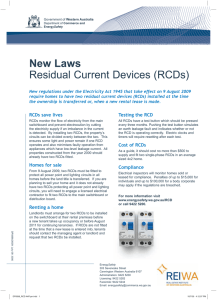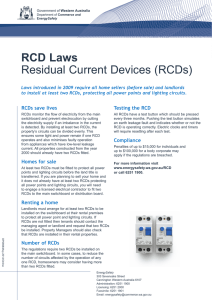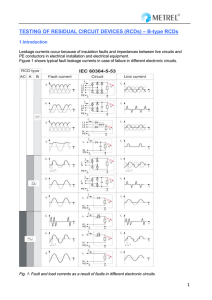Electrical Safety Standard
advertisement
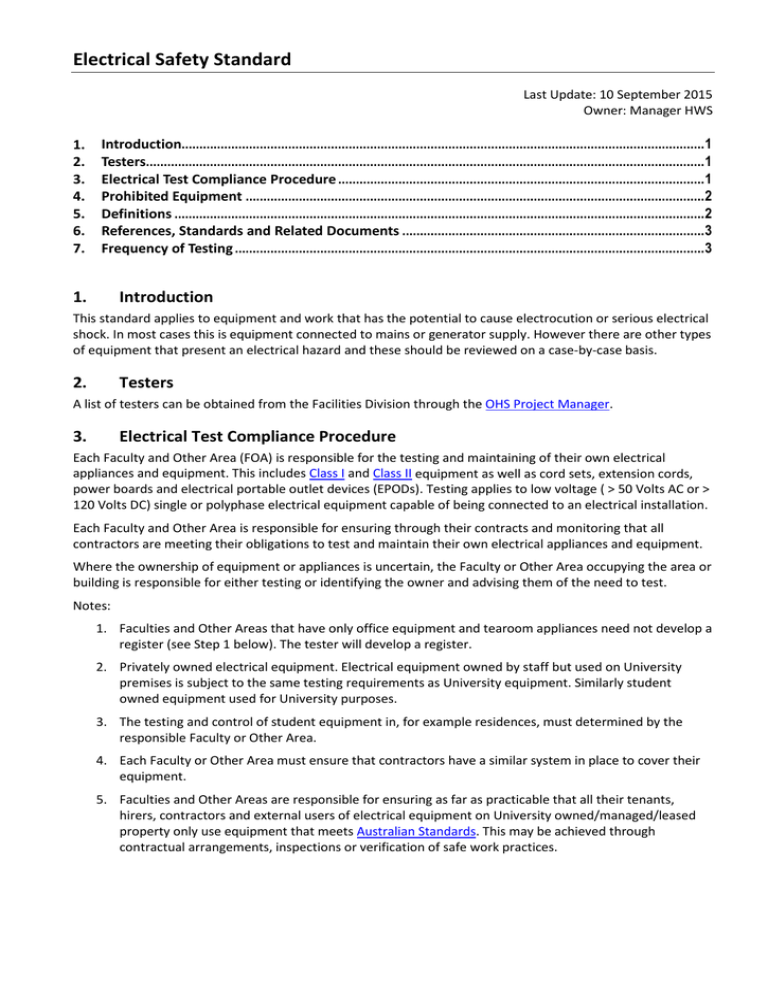
Electrical Safety Standard Last Update: 10 September 2015 Owner: Manager HWS 1. 2. 3. 4. 5. 6. 7. Introduction...................................................................................................................................................1 Testers.............................................................................................................................................................1 Electrical Test Compliance Procedure .......................................................................................................1 Prohibited Equipment .................................................................................................................................2 Definitions .....................................................................................................................................................2 References, Standards and Related Documents .....................................................................................3 Frequency of Testing ....................................................................................................................................3 1. Introduction This standard applies to equipment and work that has the potential to cause electrocution or serious electrical shock. In most cases this is equipment connected to mains or generator supply. However there are other types of equipment that present an electrical hazard and these should be reviewed on a case-by-case basis. 2. Testers A list of testers can be obtained from the Facilities Division through the OHS Project Manager. 3. Electrical Test Compliance Procedure Each Faculty and Other Area (FOA) is responsible for the testing and maintaining of their own electrical appliances and equipment. This includes Class I and Class II equipment as well as cord sets, extension cords, power boards and electrical portable outlet devices (EPODs). Testing applies to low voltage ( > 50 Volts AC or > 120 Volts DC) single or polyphase electrical equipment capable of being connected to an electrical installation. Each Faculty and Other Area is responsible for ensuring through their contracts and monitoring that all contractors are meeting their obligations to test and maintain their own electrical appliances and equipment. Where the ownership of equipment or appliances is uncertain, the Faculty or Other Area occupying the area or building is responsible for either testing or identifying the owner and advising them of the need to test. Notes: 1. Faculties and Other Areas that have only office equipment and tearoom appliances need not develop a register (see Step 1 below). The tester will develop a register. 2. Privately owned electrical equipment. Electrical equipment owned by staff but used on University premises is subject to the same testing requirements as University equipment. Similarly student owned equipment used for University purposes. 3. The testing and control of student equipment in, for example residences, must determined by the responsible Faculty or Other Area. 4. Each Faculty or Other Area must ensure that contractors have a similar system in place to cover their equipment. 5. Faculties and Other Areas are responsible for ensuring as far as practicable that all their tenants, hirers, contractors and external users of electrical equipment on University owned/managed/leased property only use equipment that meets Australian Standards. This may be achieved through contractual arrangements, inspections or verification of safe work practices. Electrical Safety Standard Methodology Resources / Tools Step 1: Create a register of equipment • A copy of the assets register is a good place to start. The testing register is the responsibility of the FOA Step 2. Dispose of any old, disused or seldom used, obviously unserviceable, equipment identified during the register creation process and prior to testing. • • Do not fill up stores with old equipment. If you need to keep an old piece of equipment for a period, put a “dispose by tag ……….” on it Step 3. Set up a testing schedule based upon the register. • • See Testing Frequency Particular attention must be given to equipment that is hired or loaned to students. Step 4. Identify who is going to carry out the testing. WorkSafe considers that portable electrical items, apart from safety switches [also called Residual Current Devices (RCDs)], can be tested by a qualified tester. Given that the testing of RCDs requires considerable electrical knowledge, an electrician must carry out this work. A list of testers can be obtained from the Facilities Division through the OHS Project Manager Step 5: Ensure that all unsafe or failed items are removed from service immediately, tagged as such, and repaired or disposed of promptly. Appliances which fail a test/inspection shall be labelled with a ‘Danger – Do Not Use’ tag to indicate that they must not be used. Where testers find any portable electrical appliance in use which in their opinion gives rise to a likely risk of electrocution or other injury they will render the appliance safe, for example, by removing the plug. Step 6: As new equipment is bought, ensure that it has been tested prior to purchase (electrically approved). All new electrical equipment displaying Australian or equivalent international approval markings showing it complies with relevant safety standards need not be tested. The manufacturer is considered to be responsible for the item's safety. Used or second-hand equipment must be tested before use. 4. Prohibited Equipment The following equipment will not be tested and may be seized by the tester • Double adaptors. • Bar radiators and paraflood lamps used for heating are prohibited 5. Definitions Electrical Equipment: is an electricity conducting or consuming device / apparatus (including the cord) that is connected to or capable of being connected to the electrical installation or generates voltages above extra-low voltage. The term includes both electrical and electronic equipment. Portable electrical appliance: an item of equipment which is not part of a fixed installation but is, or is intended to be, connected to a fixed installation, or a generator, by means of a flexible cable and a plug and socket. It includes equipment that is either hand held or hand operated while connected to the supply, or is intended to be moved while connected to the supply, or is likely to be moved while connected to the supply. Qualified Tester: a person who has the necessary skills and knowledge to carry out electrical inspections that meet the Australian Standard 3760. This need not be an electrician. The Standard does not require the employment of an electrician to test all electrical equipment. If internal technical staff are to carry out the Page 2 Electrical Safety Standard inspection tests their competency must be demonstrated through evidence of attendance at an appliance safety course approved by the Office of the Chief Electrical Inspector or relevant electrical licence. 6. References, Standards and Related Documents • • 7. Visual Inspection Checklist for Electrical Safety Australian Standard 3760: In-service Safety Inspection and Testing of Electrical Equipment Frequency of Testing The Australian Standard covers seven categories of equipment including Class I and Class II equipment as well as cord sets, extension cords, power boards and electrical portable outlet devices (EPODs). Category Examples Frequency 1. Areas where maintenance and assembly is carried out or is a very hostile environment • Workshops and construction sites 6 months 2. Items regularly plugged in and unplugged, subject to regular flexing or operating in a hostile environment • Power tools, power-boards, extension leads, electronic equipment, fans, heaters, kettles. • Portable electrical appliances and tools • All electrical equipment in wet environments 12 months 3. Rarely moved electrical equipment in non-hostile environments • Fridges, dishwashers in staff kitchens. • Computer equipment, photocopiers • Laboratory equipment that is not moved. 5 years 4 Accommodation or hostel areas • Residences including microwaves, fridges etc 2 years 5. Commercial cleaning equipment • Floor polishers, vacuums 6 months 6. Hire equipment • Equipment hired out to students and others Visual check before each hire: 3 months 7. Repaired, serviced and After repair or service or second hand equipment before use Notes: • Class I equipment includes not only insulation of live parts but an earth connection via the flexible cord and power outlet to accessible conductive parts. The accessible parts will not become live if the basic insulation fails. However, the disadvantage of Class I equipment is that an electric shock can still occur if a person forms a connection between live and earthed components. • Class II (double insulated) equipment does not have an earth connection as in Class I equipment but relies on double or reinforced insulation for protection. Page 3 Electrical Safety Standard Given the mixed nature of modern laboratories the following schedule can be used: Equipment Frequency of Test Frequently moved equipment Every 12 months Equipment that has its casing removed from time to time Every 12 months Equipment that is intensively handled or used such as Every 12 months undergraduate laboratory equipment, exercise bikes, treadmills etc Extension leads and power-boards Every 12 months Equipment in a wet or corrosive environment Every 12 months Fixed electrical equipment that is rarely moved and is not in a Every 36 months corrosive or wet atmosphere such as computers, refrigerators Residual Current Devices (RCDs) must be tested by a qualified electrician. The frequency of testing depends on the type and can be determined by the electrician. Table 4 in AS 3760 suggests an appropriate schedule for testing portable (RCDs). This is reproduced below except for hire equipment. Location Push Button test (by user) Operating time and push button test Portable RCDs Fixed RCDs Portable RCDs Fixed RCDs 1. Areas where maintenance and assembly is carried out or is a very hostile environment Daily before use 6 Months 12 months 12 months 2. Items regularly plugged in and unplugged, subject to regular flexing or operating in a hostile environment 3 months 6 Months 12 months 12 months 3. Rarely moved electrical equipment in non-hostile environments 3 months 6 Months 2 years 2 years 4 Accommodation or hostel areas 6 months 6 Months 2 years 2 years 5. Commercial cleaning equipment Daily before use Not applicable 6 months Not applicable 6. Hire equipment Push button test by hirer prior to hire 3 months 12 months Page 4
